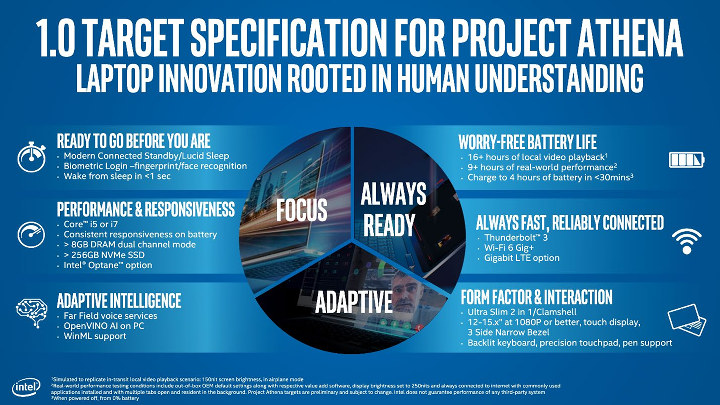Project Athena innovation program aims to provide a set of guidelines for Windows or Chrome OS always-on always-connected laptop powered by Intel processor. At the time of the first announcement at CES 2019 few details were provided, but Intel has now released Project Athena 1.0 target specification which gives clearer details of what such laptops will have to offer.
Intel also introduced new “key experience indicators” (KEI) aligned with real-world conditions in order to provide to best experience to end-users.

Project Athena 1.0 target specification defines six key areas of innovation:
- Instant Action – Modern Connected Standby and Lucid Sleep (feature of Chrome OS) features implement fast wake with a simple lid-lift, push of a button or quick fingerprint recognition. System wake from sleep must occur in less than 1 second
- Performance and Responsiveness – Systems based on Intel Core i5 or i7 processors with Intel Dynamic Tuning Technology, a minimum of 8GB DRAM dual channel mode and at least 265GB NVMe SSD including Intel Optane memory H10 options.
- Intelligence – Features such as far-field voice services and support for OpenVINO and WinML.
- Battery
- 16 or more hours of battery life in local video playback mode, and 9 or more hours of battery life under real-world performance conditions
- Fast-charging capabilities over USB Type C, integration and optimization of low-power components and co-engineering support for power efficiency.
- Connectivity – A fast and persistent connection with Intel Wi-Fi 6 (Gig+) and optional Gigabit LTE. Compatibility with USB Type C devices with Thunderbolt 3
- Form Factor – Touch display, precision touchpads and more in sleek, thin-and-light and 2 in 1 designs with narrow bezels for a more immersive experience.
I could not see a clear list of “KEI”, but Intel explains they will “verify device candidates for alignment with the KEI targets using an assessment suite running a minimum set of tasks”.
Four upcoming “Project Athena” laptops were previewed at CES 2019:
- Acer Swift 5 ultralight magnesium alloy design for mobile professionals
- Dell XPS 13” 2 in 1 with an 8% thinner form than previous gen with 10th Gen Intel Core processors, premium materials, a refined InfinityEdge display, and a 2.5mm top-mounted webcam.
- HP Envy 13” Wood Series including Amazon Alexa, wake on voice and a fingerprint reader. Privacy and peace-of-mind are ensured with HP Sure View and the HP Webcam Kill Switch solution.
- Lenovo Yoga S940 with Lenovo Smart Assist features that can detect presence and recognize voice commands for greater security and convenience.
I suppose they’ll have to come with a logo to clearly show which laptops have been “certified” with Project Athena, but there’s no such logo at this time. You’ll get more information in a fact sheet published by Intel.

Jean-Luc started CNX Software in 2010 as a part-time endeavor, before quitting his job as a software engineering manager, and starting to write daily news, and reviews full time later in 2011.
Support CNX Software! Donate via cryptocurrencies, become a Patron on Patreon, or purchase goods on Amazon or Aliexpress




